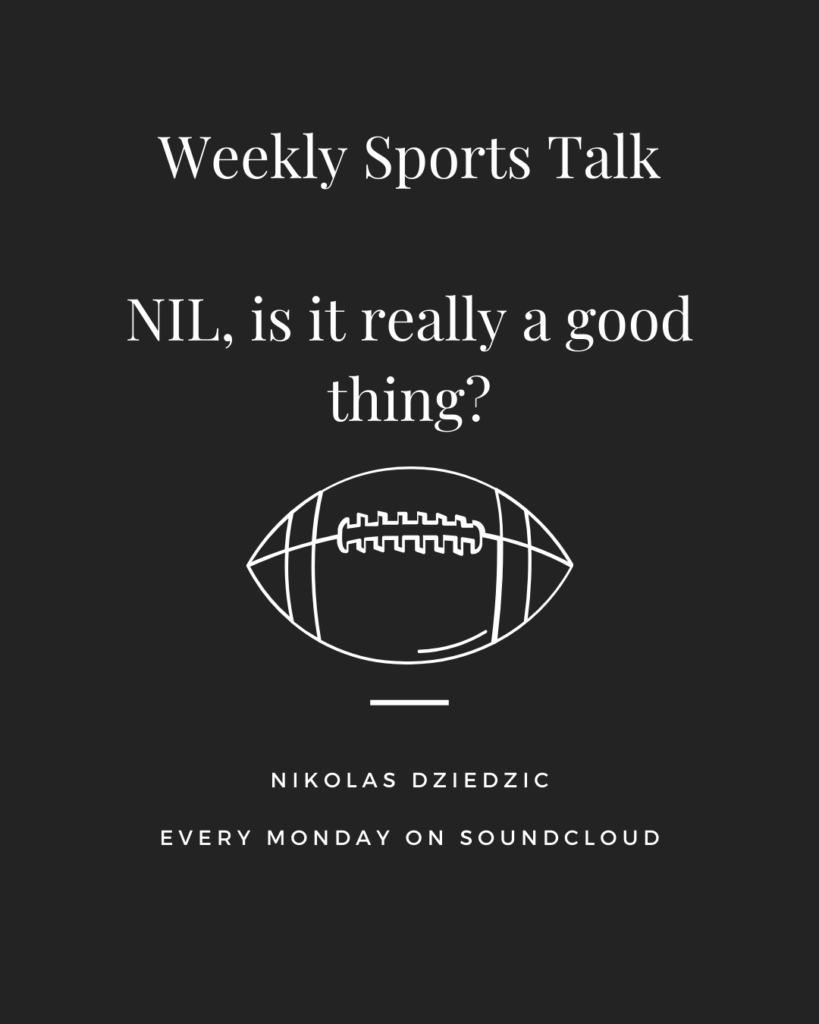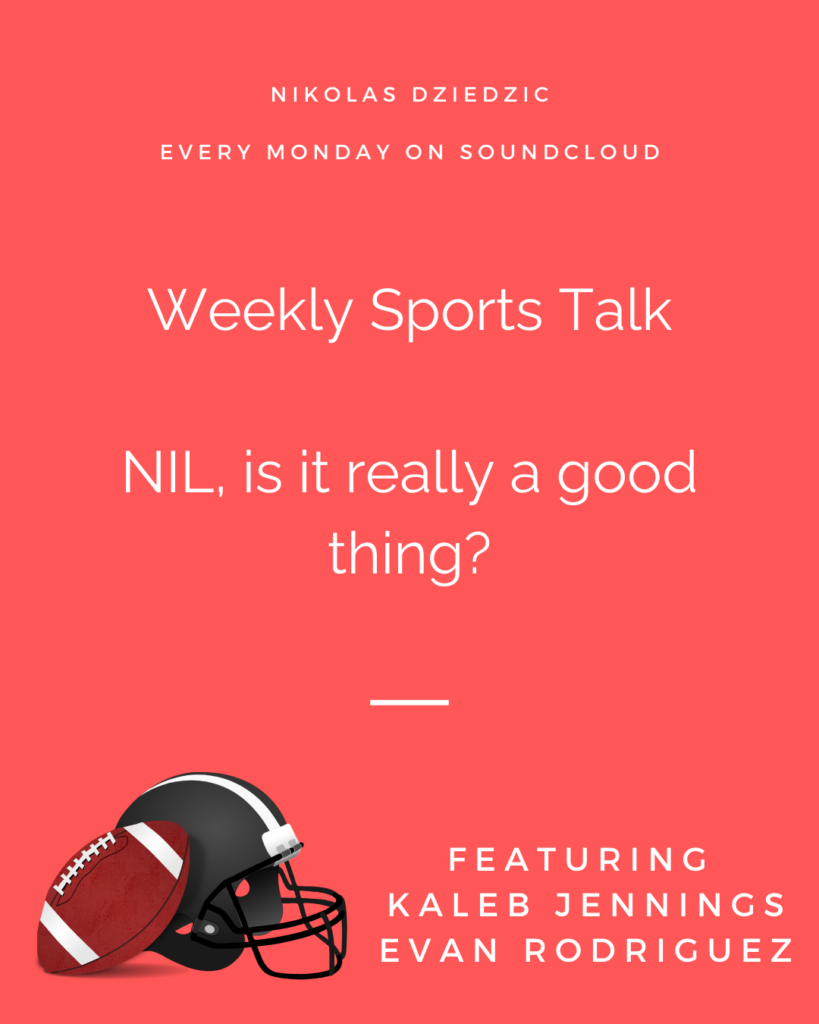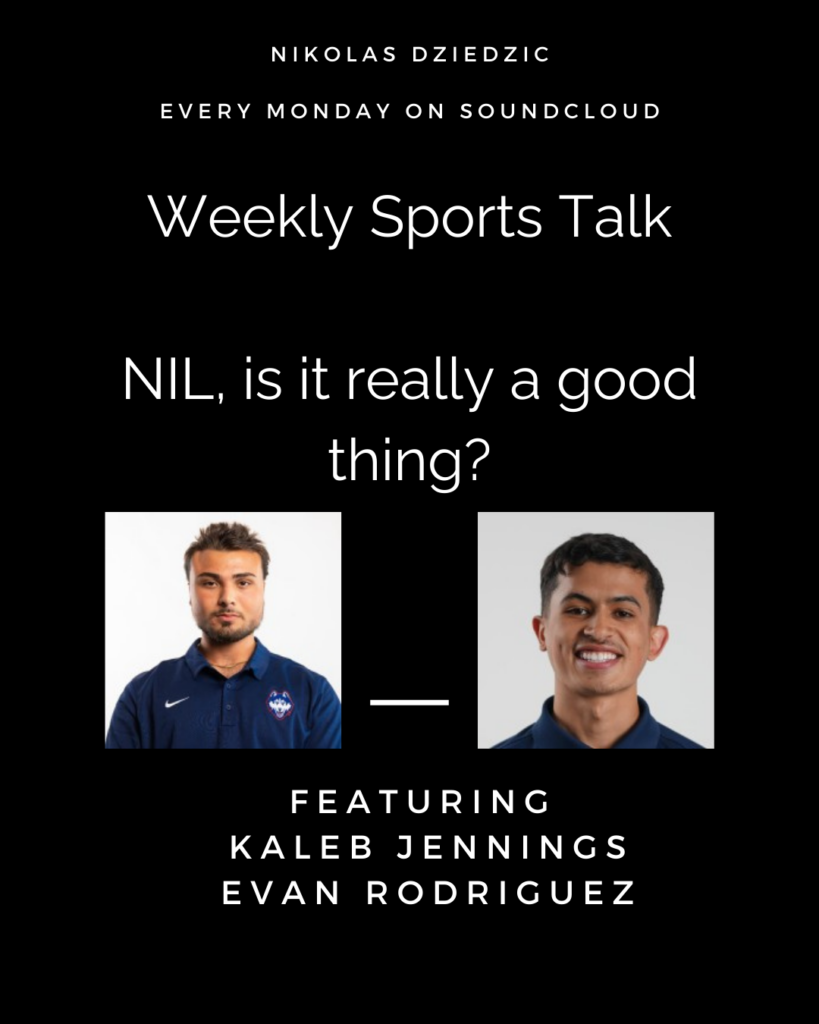The NIL program established in 2021 has officially given collegiate athletes the ability to earn income based on their skills, but it has caused some uproar on how much is too much. College athletes are starting to earn more then some pro athletes, and also some colleges have begun monopolizing the program, creating teams based solely off the fact they have more money. Today I discuss NIL issues, and NIL on our own campus with two students at the University of Connecticut who have deeper understandings on the program.
TRANSCRIPT:
Niko: In recent years, college athletes have finally been able to receive payment for their skillsets, in the form of Name Image Likeness money. July 1st, 2021, the NCAA approves new rules that finally allow collegiate athletes to profit from their autograph, endorsement deals, and business ventures.
Niko: NIL has changed the landscape of college sports in many ways, and many believe that it has changed the game for the worse. NIL has officially added a business model to playing a college sport, meaning athletes are constantly chasing the best way to earn more income.
Niko: My name is Nikolas Dziedzic, and I am here with
Kaleb: Kaleb Jennings
Niko: It is my understanding that you did a research article on this topic right?
Kaleb: Yes, I did.
Niko: First and foremost, do you think college athletes deserve to be paid?
Kaleb: College Sports is a very profitable business, especially football and basketball. You know, they’re making so much money, and I have seen how much these kids work and put so much time into it, they’re earning so much for the programs. They deserve more than a scholarship, especially because it is so hard to make it to the next level and finally get the money. If you are making money for a program, and not good enough to be in the pros, you still deserve to be compensated. I do think it is a little out of hand now because there is no cap on it, so it’s easy for players to flip flop schools.
Niko: a great example of NIL affecting players careers is Miami’s new quarterback Carson Beck. Beck got hurt this past season and was knew that his chances in the NFL draft were slim, but the University of Miami offered him a large sum of money around the 3–4‑million-dollar range. To put this into perspective, the top 12 NFL draft picks are expected to receive 5 million dollars a year.
Kaleb Jennings: I think it is a little crazy, especially as someone who has not won a national championship, or a Heisman, and has never been in those conversations. To be making as much as an NFL first round rookie contract.
Niko: as great as it is for these young student athletes to be succeeding and bringing in largescale income for their talents, unfortunately the current NIL and transfer portal model has created a rough scenario, athletes leaving their teams for more money. Currently there is no limit to transferring, so athletes can leave their school anytime they have a better offer elsewhere. This has led many to wonder how much is too much.
Kaleb: But the fact that players can go to a school for a year, go to schools for not even a whole season, but only a period, for just a spring or for just a fall, and then transfer and go get money somewhere else and can do this, I’ve seen it done now three, four times in one player’s career. I think it’s a little absurd, and I think that’s where the issue lies.
Niko: I completely agree with that, players no longer have dream schools, they just go where they can get paid the most, and it just leads to super teams.
Niko: More than 31000 athletes entered the transfer portal last year, all looking for the best opportunity to play their sport at a different school for either more money… or playing time.
Niko: Storrs Central, the “official NIL partner of UConn Athletics”, is a news site that offers paid subscription tiers, as well as hosts their own fundraising, to provide NIL money to our campus’s athletic programs. Evan Rodriguez, a writer and photographer for the organization, is with me to talk about NIL through his eyes as a member of an NIL program.
Evan Rodriguez: So essentially Storrs Central was started as sort of like na adjacent company with bleed blue for good. Essentially with the house settlement and everything, a lot of schools are moving away from, you know, having those types of companies handle a lot of charity work and that type of stuff. So, Storrs Central has shifted more to be a marketing agency for these players to get deals. We partnered with Peoples Bank and they’re doing an opening in Avon tomorrow. So, you can essentially meet Sarah Strong, Solo Ball, and Terrace Reid from the basketball teams. They get paid and can help the community come together. It’s essentially a marketing agency moving away from Bleed Blue for Good.
Niko: Yeah, that’s dope, so you guys are kind of giving the players a platform?
Evan: Yeah, and you know, finding a way to get the school and the players more NIL dollars, which has become obviously a big part of athletics in 2025. I think the greatest thing with UConn is that they’ve allowed themselves to be super competitive in the NIL landscape, even with them not being in a Power 5 conference for football specifically, where you’re seeing schools make tons and tons of cash or have a large donor base. But UConn with their large fan base and how theyve been able to stay competitive on the NIL front. Like, Storrs Central is essentially designed to help them stay competitive. You essentially buy a subscription for Storrs Central and then that money goes towards the players. Also, if I make a graphic and I put another companies’ logo, that money will go toward the players as well. Or any company deals that were able to help the market for them will also go toward the players.
Niko: Storrs Central did get the logo at the Rent [Rentschler Field] , Right?
Evan: WE did yeah
Niko: So would you say that logo there generated more traffic and money?
Evan: Absolutely yes. So from the moment it was announced, it was one of the more unique NIL deals that we saw in college athletics to the point where it was pretty much immediately marketed on ESPN. It was pretty quickly featured on the Pat McAfee show, and we did not even think it would actually garner that much attention. It was a great marketing tool not only for the school, but also our company, to the point where we were able to sort of become more a face of helping to market football. One of our biggest donors to Storrs Central, is Mike Burton, and he is also like one of the biggest faces of the UConn football donor base. Its been pretty cool, Like its definitely helped to grow the company and helped earn the players more money as well.
Niko: Do you truthfully believe that we are going to keep raising more money and we are going to be able to keep building our team?
Evan: Yeah absolutely, I think UConn football specifically, like the fact that Mike Burton has been super like, focused on helping, you know, raise that money. I feel like that does affect them in a such a positive way. He’s helping other people get involved with UConn Football, and even specifically with Storrs Central, as that company grows, they’re going to be able to help generate more money for UConn Football and help them be able to stay competitive in the NIL landscape. We are already seeing them be able to attract so many more high-profile transfers than they were able to, even back when I worked for them. So, I think they’re in a really good spot right now, and I think that it is only going to grow from here.
Niko: NIL is a great addition to the college athletic landscape. It is good to see that athletes are no longer being used as cash cows for large campuses to profit, but there are certain things that need to happen to prevent this from being abused. I think that a limit on transferring would be a good solution, so that teams can still retain their players without trying to spend more and more money every new season, but I want you as the viewers should let me know what you think about the concept as a whole!
Thank you everyone for listening and have a good day.
Social Posts


